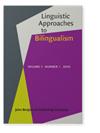Does your regional variety help you acquire an additional language?
IF 1.8
2区 文学
0 LANGUAGE & LINGUISTICS
引用次数: 1
Abstract
This study investigates Differential Object Marking (DOM) in Italian speakers from two dialectal areas–North and South Italy–learning Spanish. Southern Italo-Romance varieties exhibit a DOM system through a-marking, like Spanish, whereas the Northern varieties, like Standard Italian, only allow DOM with pronouns. Given the structural differences and similarities among these typologically close languages, we ask whether a stigmatized oral regional variety has the potential to transfer in the acquisition of additional languages. Participants (n = 103) completed an acceptability judgment task (AJT) and an oral production task testing DOM in [±animate, ±definite] DP contexts. The results revealed differences modulated by proficiency in the written AJT that moderately favored the Northern learners and in the oral production task that favored the Southern learners. These findings suggest that low-prestige varieties may not have the full potential to transfer at early stages of acquisition due to their inhibition in formal contexts, but that they can emerge in less formal tasks. We argue that current theoretical models that prioritize linguistic proximity as the primary source of transfer at initial stages of L3 acquisition are unable to capture revealing patterns from understudied sociolinguistic contexts that bring new light to the study of multilingualism.你所在地区的多样性对你学习一门额外的语言有帮助吗?
摘要本研究调查了意大利南北两个方言区意大利语使用者学习西班牙语时的差异对象标记(DOM)。南部的italo -罗曼语变体像西班牙语一样通过-标记展示DOM系统,而北部的italo -罗曼语变体像标准意大利语一样,只允许带有代词的DOM。考虑到这些类型学上相近的语言在结构上的差异和相似之处,我们想知道一个被污名化的口头区域变体是否有可能在其他语言的习得中转移。参与者(n = 103)完成了可接受性判断任务(AJT)和在[±动画,±确定]DP情境下测试DOM的口头生产任务。结果显示,北方学习者在书面AJT上的熟练程度适中,而南方学习者在口头生产任务上的熟练程度较高。这些发现表明,由于在正式环境中受到抑制,低声望的变体在习得的早期阶段可能没有充分的转移潜力,但它们可以在较不正式的任务中出现。我们认为,当前的理论模型优先考虑语言接近性作为三语习得初始阶段迁移的主要来源,无法从研究不足的社会语言学背景中捕捉揭示模式,这些模式为多语研究带来了新的启示。
本文章由计算机程序翻译,如有差异,请以英文原文为准。
求助全文
约1分钟内获得全文
求助全文
来源期刊

Linguistic Approaches To Bilingualism
Social Sciences-Linguistics and Language
CiteScore
3.20
自引率
9.10%
发文量
24
期刊介绍:
LAB provides an outlet for cutting-edge, contemporary studies on bilingualism. LAB assumes a broad definition of bilingualism, including: adult L2 acquisition, simultaneous child bilingualism, child L2 acquisition, adult heritage speaker competence, L1 attrition in L2/Ln environments, and adult L3/Ln acquisition. LAB solicits high quality articles of original research assuming any cognitive science approach to understanding the mental representation of bilingual language competence and performance, including cognitive linguistics, emergentism/connectionism, generative theories, psycholinguistic and processing accounts, and covering typical and atypical populations.
 求助内容:
求助内容: 应助结果提醒方式:
应助结果提醒方式:


